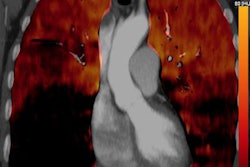
A Dutch-led research team has used a set of clinical rules to enable almost 40% of pregnant women suspected of having a pulmonary embolism (PE) to avoid an unnecessary CT pulmonary angiography (CTPA) examination. Their findings were published in the 21 March edition of the New England Journal of Medicine.
Recent concerns about the overuse of diagnostic tests for pulmonary embolism have spurred the development of clinical criteria that could potentially rule out PE for some patients without the need for them to undergo additional testing or imaging. Unlike most patients, however, pregnant women are at a greater risk of blood clots and subsequent PE.
Recognition of this elevated risk has led to an increase in improper diagnostic management of suspected PE for pregnant patients, with physicians more or less always ordering a CTPA exam or a lung scintigraphy ventilation/perfusion (V/Q) scan for these patients, noted first author Dr. Liselotte van der Pol from Leiden University Medical Center and colleagues.
In the current prospective study, the researchers took a set of clinical criteria known as the YEARS diagnostic algorithm -- originally intended for all patients with clinically suspected PE -- and adapted it specifically for pregnant women. The study population included 494 pregnant patients who were clinically suspected of having PE at one of 18 hospitals between October 2013 and May 2018 (NEJM, 21 March 21 2019, Vol. 380:12, pp. 1139-1149).
The researchers' new clinical guidelines ruled out the likelihood of PE in pregnant women by confirming a score of less than 1,000 ng/mL on a D-dimer blood test, as well as the absence of three signs from the YEARS criteria:
- Deep-vein thrombosis
- Hemoptysis
- PE considered to be the most likely diagnosis by a physician
The group also ruled out PE if a patient met one or more of the YEARS criteria but had a D-dimer score of less than 500 ng/mL.
Among the 299 patients who met the group's YEARS clinical rules for subsequent diagnostic imaging, 15 had confirmed PE on a CTPA exam and one on a lung scintigraphy ventilation/perfusion (V/Q) scan. For the 195 patients who did not meet the clinical rules -- and, thus, did not need to undergo a CTPA exam -- none ended up having a PE up to 90 days after the initial exam, and only one patient had a deep-vein thrombosis.
| Success of YEARS clinical criteria for ruling out PE during pregnancy | ||
| Did not meet clinical criteria for PE (CTPA not indicated) | Met the clinical criteria for PE (CTPA indicated) | |
| Presence of PE | 0% (0/195) | 5.4% (16/299) |
Relying on the group's clinical rules allowed 39% of the pregnant patients suspected of having a PE to avoid undergoing a CTPA or V/Q scan -- safely averting unnecessary radiation exposure to the fetus and mother, according to the authors.
Despite the availability of the clinical rules, physicians still failed to follow the appropriate procedure when deciding whether or not to order a CTPA exam on multiple occasions in the study, emphasizing the great challenge of managing PE in pregnant women, van der Pol and colleagues noted.
Nonetheless, the success of relying on a standardized algorithm for the diagnosis of PE in previous studies, along with "the positive results of the current study (i.e., the very low number of diagnostic failures and high efficiency of the algorithm), strongly supports the relevance and generalizability of the pregnancy-adapted YEARS approach," they concluded.



















